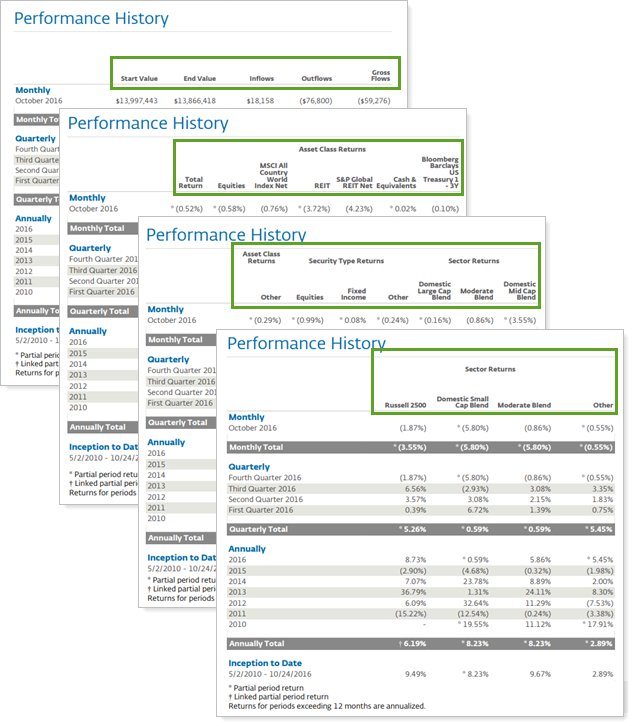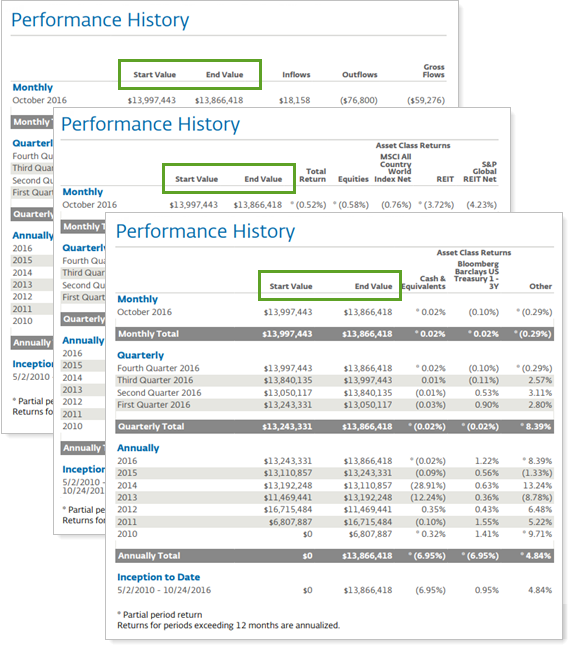Contents
|
|
How Continue Columns on Additional Pages if Width is Greater than One Page Works
| Applies to: | ||
|---|---|---|
| Dynamic |
Client Portal |
|
On the Performance History report, you may want to include more columns than comfortably fit onto the width of one page. In this case, this setting allows you to roll over the extra columns onto the following pages. You can also choose whether to have columns from the first page repeat on following pages.
You might choose to use this setting if you want to display a substantial amount of information around returns. For internal firm use, this setting can be useful, since seeing data across multiple pages may be less of an obstacle to firm users. Conversely, perhaps this setting is turned off for client-facing reports, if the firm determines the section should be kept simpler for clients.
In Dynamic Reports
This report is available for PDF reports only.
In PDF Reports

Performance History reports with many columns added may be too wide to fit onto one page. In this case, select the Continue columns on additional pages if width is greater than one page check box to generate a report that continues the columns on the following pages. When you select this option, you can set how many columns from the first page you want to repeat on following pages using Repeat First X Columns On Additional Page.
The exact number of columns that fit on a page depends on your PDF report theme and the data displayed.
If you do not select this check box and the number of columns is too wide for the page, you will see a rendering error that says, The selected columns will not be rendered in the width allotted. Please either remove column(s) or reduce column widths.
| Continue Columns on Additional Pages... selected |
|---|
|
A user creates a Performance History report that includes a large number of other columns, returns for three different category, and category benchmarks. When the report runs, the selected columns start on the first page and continue on to four total pages.
|
When you select Continue columns on additional pages if width is greater than one page, the following setting also is available.
Repeat First X Columns On Additional Page

Repeat first X columns on additional pages allows you to designate how many columns from the first page are carried over onto following pages. This helps provide context to the information on the following pages. When you select a certain number of columns to include, the report will start with the farthest left column and count number of columns to the right.
-
To show only the date periods and intervals column on each page, leave the Repeat first X columns on additional pages set to 1.
-
To roll over more columns from the first page onto following pages, choose the desired number of columns from the Repeat first X columns on additional pages list.
NoteS
-
The first column, which always displays date periods and intervals, counts as column 1. Take this into account when deciding how many columns to repeat.
For example, if you set up the report to show the Start Value and End Value as the first two columns after the date periods column, you would choose 3 from the Repeat first X columns on additional pages list.
-
If any columns selected to repeat don't have data, they will be dropped so the page displays information efficiently.
-
| Repeat First X Columns On Additional Pages selected and set to 3 |
|---|
|
A user creates a Performance History report with a large number of columns, starting with Start Value and End Value and including categories and benchmarks. The user wants to include Start Value and End Value on every page of the report, so they repeat the first three columns on additional pages. When the user runs the report, the intervals column and the next two columns—Start Value and End Value—appear on every page.
|
Reports With This Setting
Performance Reports
|
|
Related Settings
For more information about setting up PDF report themes, see PDF Themes.




